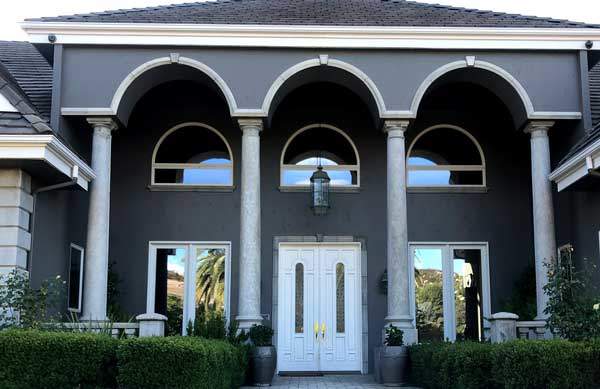Budget-friendly Residential Window Tint Options for every single Spending plan
Budget-friendly Residential Window Tint Options for every single Spending plan
Blog Article
Just How Residential Window Tinting Enhances Your Home's Power Performance
Residential home window tinting offers an engaging service for homeowners seeking to improve energy effectiveness within their living spaces. By using specialized films to windows, it effectively minimizes heat transfer, thus supporting interior temperatures and lessening the need for extreme home heating or air conditioning.
Comprehending Window Tinting
Comprehending home window tinting is important for home owners seeking to enhance both convenience and energy effectiveness in their home. Residential Window Tint. Home window tinting entails the application of a thin film to the interior or outside surface of glass windows. This film can considerably modulate the amount of sunshine and warmth that gets in a home, therefore affecting indoor environment problems
There are numerous sorts of window tinting films readily available, each with distinct residential or commercial properties. Colored movies absorb solar energy, while reflective movies disperse it away from the glass surface. Ceramic films use a balance of exposure and warmth denial, making them a popular selection amongst home owners. The performance of window tinting is usually gauged by its Visible Light Transmission (VLT) portion, which shows just how much light can go through the film.
Benefits of Power Efficiency
Window tinting not just boosts visual appeals however also plays a significant role in improving energy effectiveness within property spaces. By reducing warm transfer with home windows, colored movies produce an extra stable indoor environment, which can lead to significant decreases in power intake for heating & cooling. This energy performance converts into reduced energy bills, providing house owners with significant lasting savings.

In addition, window tinting boosts the convenience of living rooms. By minimizing glare and obstructing dangerous UV rays, tinted windows develop a more pleasurable setting, which can result in enhanced well-being for owners. The security versus UV rays additionally aids maintain furnishings and floor covering from fading, adding to the durability of household products.
How Tinting Works
Tinting movies operate via a mix of innovative products and innovations created to regulate the amount of solar energy entering a home. Largely made up of polyester, these films typically incorporate metallic or ceramic particles that take in and show warm. This twin capacity enables them to significantly lower the penetration of ultraviolet (UV) rays and infrared radiation while permitting visible light to pass through.
The performance of home window tinting is gauged by its solar warm gain coefficient (SHGC), which indicates how much solar power is transmitted via the home window. Reduced SHGC values are better as they denote greater warmth rejection. Furthermore, window tints can feature a selection of shades, permitting home owners to customize their visual preferences while enhancing energy effectiveness.
In addition, these films function as an obstacle, protecting against warmth loss during cooler months by mirroring interior heat back into the space. This thermal insulation effect matches the air conditioning benefits gained during warmer months, adding to a well balanced indoor climate year-round. By handling solar power effectively, property window tinting not only enhances convenience but likewise plays a crucial function in minimizing power intake and reducing utility bills.
Picking the Right Tint

There are different kinds of home window movies available, consisting of dyed, metalized, and ceramic. Ceramic films supply excellent heat control without jeopardizing exposure and are very long lasting, making them a popular choice.
Visible light transmission (VLT) is one more crucial variable, as it indicates the amount of all-natural light that can travel through the colored glass. Homeowners must choose a color with a VLT that enhances their illumination preferences while still offering sufficient glare decrease.
Furthermore, assessing the solar heat gain coefficient (SHGC) can aid establish how well a tint can block warm from sunlight. A lower SHGC suggests better heat control, inevitably improving energy effectiveness.
Installment and Maintenance Tips
Proper setup and upkeep are crucial elements in maximizing the advantages of property window tinting. Specialists additionally utilize specialized techniques and devices, which can improve the resilience and efficiency of the tint.
Adhering to installment, maintenance is vital to extend the life of the window film. It is recommended to wait a minimum of thirty day prior to cleaning up the colored home windows to enable the adhesive to heal fully. When cleansing, utilize a soft cloth and a gentle, ammonia-free cleaner to prevent damaging the film. Avoid abrasive materials that can damage the surface.
Furthermore, normal inspections are valuable. Inspect for any kind of peeling or like it bubbling, which could suggest inappropriate installation or wear with time - Residential Window Tint. Addressing these concerns promptly can stop additional damage and keep energy efficiency. By sticking to these installation and upkeep ideas, home owners can ensure their home window tinting remains to provide significant power savings and comfort for many years ahead.
Final Thought
In final thought, household home window tinting offers as a reliable option for boosting power efficiency within homes. By decreasing heat transfer and obstructing hazardous UV rays, home window movies add to decrease power consumption and improved indoor convenience.
Window tinting involves the application of a slim film to the interior or exterior surface of glass home windows. By minimizing warm transfer through windows, colored movies develop a more steady interior environment, which can lead to significant reductions in power usage for home heating and air conditioning.The performance of window tinting is determined by its solar heat gain coefficient (SHGC), which indicates how much solar energy is transmitted with the window. By handling solar power properly, household home window tinting not just boosts convenience yet additionally plays an important role in check out this site decreasing power consumption and reducing utility costs.
By minimizing warm transfer and blocking harmful UV rays, window films add to decrease energy consumption and boosted interior comfort.
Report this page